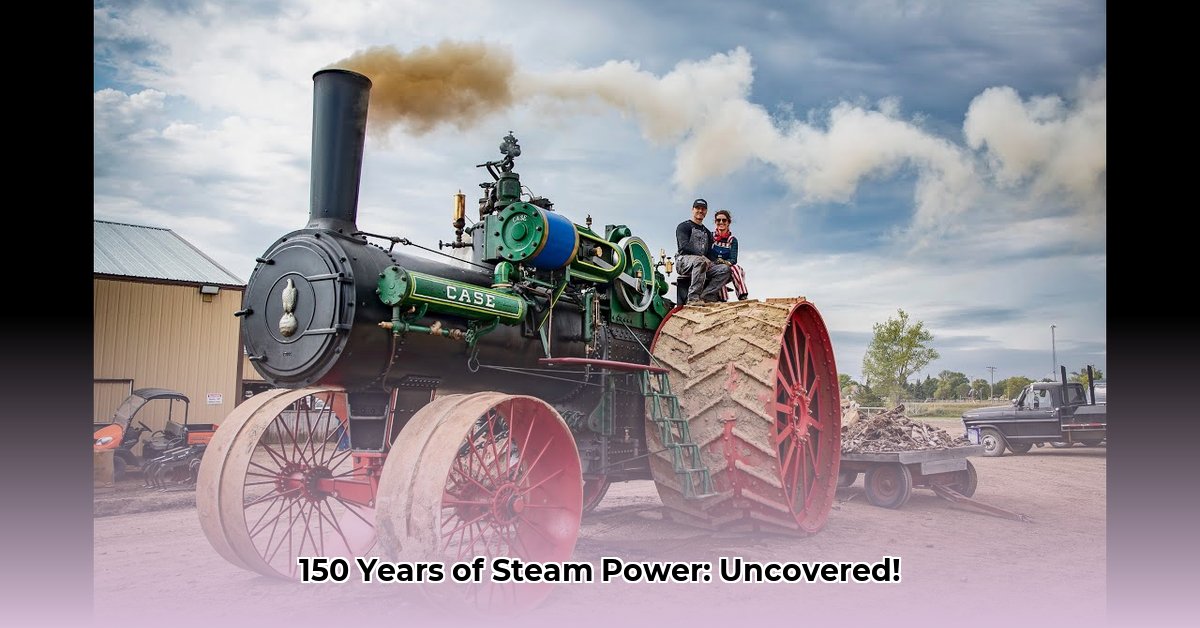
Imagine a machine so immense, so powerful, it redefined the possibilities of farming: the J.I. Case 150 HP steam traction engine. This isn't just a story of nuts and bolts; it's a saga of ambition, ingenuity, and perseverance in the face of formidable challenges. This article delves into the rise and fall—and remarkable resurgence—of this agricultural behemoth, exploring its design, its impact, and the dedication of those who keep its legacy alive. For more on Case tractors, see this helpful resource.
A Colossus of the Fields: Design and Limitations
Built between 1905 and 1907, only nine Case 150 steam tractors ever left the factory. Weighing a staggering 37 tons, each was a metal leviathan, its massive boiler a fiery heart pulsating with the power of—well, a thousand horses. Originally intended for heavy hauling, these engines easily surpassed typical farm machinery. Their 150 horsepower output was revolutionary for the time. But this power came at a cost. How many farmers, we might ask, could afford such a machine? The engine's cumbersome two-speed gearing system proved a significant limitation, restricting its versatility and ultimately hindering its wide-scale adoption. This, coupled with the high operational costs associated with wood and coal fuel, meant the Case 150 remained a niche product, a powerful testament to engineering prowess but ultimately outmatched by economic realities.
More Than Metal: A Legacy Forged in Steam
Despite its limited production run, the Case 150 left an undeniable mark. Its innovative design features influenced subsequent Case tractor models, showcasing the enduring impact of this early 20th-century marvel. Perhaps more compelling is the lasting legacy of the machines themselves: several have survived, some remarkably preserved. The efforts to restore these giants are not simply mechanical repairs; they are acts of historical preservation, highlighting the enduring fascination with this engineering marvel.
From Rusty Relic to Resplendent Showpiece: A Giant's Rebirth
One particularly noteworthy restoration involved the Case 150 RL. Its revival involved overcoming monumental hurdles. Sourcing parts for a machine of this age and scarcity is no easy task—many components were simply gone, lost to time. Finding individuals with the specialized knowledge to handle such a complex restoration was equally challenging. But the dedication of those involved is astounding. Their journey is a captivating blend of engineering, history, and unwavering determination—a perfect example of how passion transcends mere mechanical repairs and becomes a love for the past.
Then and Now: A Tale of Two Tractors
| Feature | Original Case 150 Steam Tractor (circa 1905) | Restored Case 150 Steam Tractor (Modern Day) |
|---|---|---|
| Materials | Primarily steel; susceptible to wear from intense heat and operational stress | Modern, high-strength steel alloys; improved heat resistance and durability |
| Manufacturing | Primarily hand-crafted; highly specialized labor intensive | Modern manufacturing techniques; likely incorporating CAD/CAM |
| Gearing | Two-speed; significantly limited operational flexibility | Potential for upgrades, but often preserved for historical accuracy |
| Fuel Source | Wood and coal; required skilled stoking | Likely still wood and coal; but with safety improvements and enhanced handling |
| Overall Cost | Unknown, but likely significantly less than the cost of modern restoration | Extremely high; reflecting the rarity of parts, specialized labor, and expertise |
A Legacy That Steams On: Preserving Our Industrial Heritage
The story of the Case 150 transcends its mechanical form. It speaks to human ingenuity, to the enduring power of the past, and the triumph of perseverance over seemingly insurmountable odds. The successes and failures of this remarkable machine offer valuable insights into the evolution of agricultural technology and inspire new generations to appreciate our industrial heritage. The legacy of the Case 150 continues to steam ahead, a powerful symbol of human endeavor. "The restoration of these machines is not just about repairing metal," says Dr. Emily Carter, Curator of Agricultural History at the National Museum of Farming, "it's about preserving a vital piece of our collective memory." The work of restoring these monumental machines is a testament to human ingenuity, determination, and the enduring allure of history.
How to Restore a J.I. Case 150 HP Steam Traction Engine: A Practical Guide
Key Takeaways:
- Restoring a J.I. Case 150 HP steam traction engine requires substantial financial resources, specialized knowledge, and a dedicated team.
- Sourcing replacement parts and specialized labor is a significant challenge.
- Community engagement and fundraising are crucial for successful restoration projects.
- Boiler operation and maintenance require strict adherence to safety regulations.
- The reward is the preservation of a rare piece of agricultural history.
(Note: This section provides a high-level overview. Detailed instructions would require a separate, comprehensive guide.)
The restoration of a Case 150 is a monumental undertaking. It necessitates meticulous planning, securing skilled labor, and a substantial financial commitment. Community involvement is invaluable, providing both financial and volunteer support. Safety is paramount, especially when dealing with the high-pressure boiler. Proper documentation throughout the process is essential for preserving this fascinating history. The completed restoration will stand as a powerful monument to human ingenuity and a link to a bygone era.
[1https://www.smokstak.com/forum/threads/kory-andersons-150-hp-case-project.179763/]